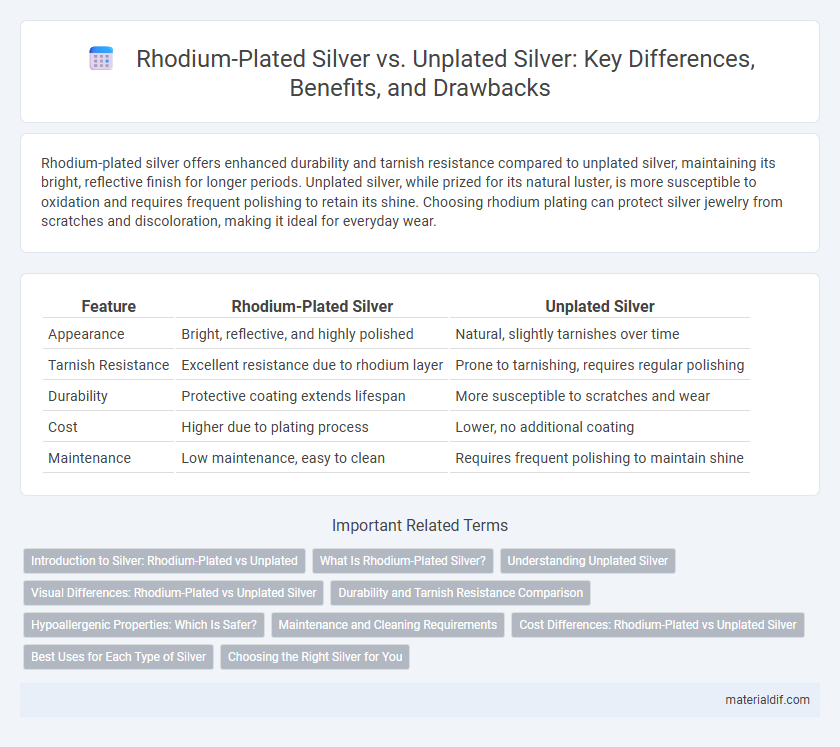Rhodium-plated silver offers enhanced durability and tarnish resistance compared to unplated silver, maintaining its bright, reflective finish for longer periods. Unplated silver, while prized for its natural luster, is more susceptible to oxidation and requires frequent polishing to retain its shine. Choosing rhodium plating can protect silver jewelry from scratches and discoloration, making it ideal for everyday wear.
Table of Comparison
| Feature | Rhodium-Plated Silver | Unplated Silver |
|---|---|---|
| Appearance | Bright, reflective, and highly polished | Natural, slightly tarnishes over time |
| Tarnish Resistance | Excellent resistance due to rhodium layer | Prone to tarnishing, requires regular polishing |
| Durability | Protective coating extends lifespan | More susceptible to scratches and wear |
| Cost | Higher due to plating process | Lower, no additional coating |
| Maintenance | Low maintenance, easy to clean | Requires frequent polishing to maintain shine |
Introduction to Silver: Rhodium-Plated vs Unplated
Rhodium-plated silver features a thin layer of rhodium, a rare and corrosion-resistant metal, enhancing its durability and resistance to tarnish compared to unplated silver. Unplated silver, primarily composed of pure silver or sterling silver alloy, offers a classic sheen but requires frequent cleaning to maintain its luster. The rhodium plating provides a protective barrier, resulting in a brighter finish and increased longevity, making it ideal for jewelry and high-wear items.
What Is Rhodium-Plated Silver?
Rhodium-plated silver features a thin layer of rhodium metal applied to sterling silver, enhancing durability and resistance to tarnish compared to unplated silver. This plating provides a reflective, bright white finish that maintains its shine longer and offers a protective barrier against scratches and environmental factors. Unplated silver, typically sterling silver with 92.5% purity, naturally oxidizes over time, requiring frequent cleaning to preserve its luster.
Understanding Unplated Silver
Unplated silver, composed of 92.5% pure silver and 7.5% other metals, is prized for its natural luster and hypoallergenic properties. Unlike rhodium-plated silver, which has a thin layer of rhodium to enhance durability and tarnish resistance, unplated silver maintains its authentic metallic surface that develops a unique patina over time. Collectors and purists prefer unplated silver for its authenticity and the depth of character that forms with natural oxidation.
Visual Differences: Rhodium-Plated vs Unplated Silver
Rhodium-plated silver exhibits a bright, reflective white finish that resists tarnishing, enhancing the jewelry's durability and longevity compared to unplated silver. Unplated silver has a softer, warmer sheen that gradually develops a patina or tarnish over time, requiring regular polishing to maintain its original luster. The higher gloss and scratch-resistant surface of rhodium plating make it a popular choice for modern, high-shine silver pieces.
Durability and Tarnish Resistance Comparison
Rhodium-plated silver offers superior durability and tarnish resistance compared to unplated silver, as the rhodium coating acts as a protective barrier against oxidation and scratches. Unplated silver is more prone to tarnishing due to its direct exposure to sulfur and moisture, requiring frequent cleaning to maintain its shine. The enhanced hardness of rhodium plating extends the lifespan of silver jewelry, making it ideal for everyday wear.
Hypoallergenic Properties: Which Is Safer?
Rhodium-plated silver offers enhanced hypoallergenic properties compared to unplated silver due to its protective layer that minimizes skin exposure to reactive metals like copper and nickel often found in alloyed silver. Unplated silver, especially sterling silver containing trace amounts of these metals, can cause allergic reactions in sensitive individuals. Choosing rhodium-plated silver reduces the risk of skin irritation and is safer for people with metal allergies.
Maintenance and Cleaning Requirements
Rhodium-plated silver requires less frequent polishing than unplated silver due to rhodium's resistance to tarnish and corrosion, making it easier to maintain a bright, shiny surface. Unplated silver tarnishes more quickly from exposure to air and moisture, necessitating regular cleaning with silver polish or mild soap and water to prevent discoloration. Using a soft cloth and gentle cleaning methods is essential for both types to preserve their finish and prevent scratching.
Cost Differences: Rhodium-Plated vs Unplated Silver
Rhodium-plated silver typically costs more than unplated silver due to the added expense of the rhodium coating process and the price of rhodium metal, which is significantly higher than silver per ounce. The plating enhances durability and tarnish resistance, justifying the premium despite silver's intrinsic value remaining constant. Unplated silver offers a lower upfront cost but requires more maintenance to prevent oxidation and maintain its appearance, impacting long-term value assessments.
Best Uses for Each Type of Silver
Rhodium-plated silver offers enhanced durability and tarnish resistance, making it ideal for high-wear jewelry such as rings and bracelets that require long-lasting shine. Unplated silver provides a natural luster favored for intricate designs and heirloom pieces where traditional silver's patina over time adds character. Choosing between rhodium-plated and unplated silver depends on whether longevity and low maintenance or authentic aging and detail preservation are prioritized.
Choosing the Right Silver for You
Rhodium-plated silver offers enhanced durability and a brilliant, tarnish-resistant finish, making it ideal for jewelry that requires long-lasting shine and low maintenance. Unplated silver, while prone to oxidation, provides a classic, natural patina that many collectors and enthusiasts appreciate for its authentic aging process. Selecting the right silver depends on your preference for maintenance and appearance: choose rhodium plating for a sleek, polished look or unplated silver to enjoy a timeless, evolving character.
Rhodium-Plated Silver vs Unplated Silver Infographic

 materialdif.com
materialdif.com